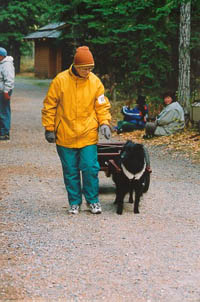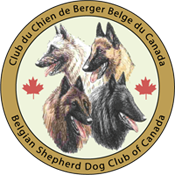Carting / Draft Work
Why Have your Belgian in a Draft? (Test that is)
By Shauna Attewell
 One of the more rapidly growing sports in the dog fancy is carting, also known as draft work. This sport has been the bastion of the large breeds traditionally known for their draft work - Bernese Mountain Dogs and Newfoundlands, but recent entries at CKC Sanctioned Draft Test have shown a wide assortment of breeds entered, everything from Miniature Poodles to Mastiffs from Bloodhounds to Belgian Sheepdogs (you knew we would get around to Belgians sooner or later didn't you).
One of the more rapidly growing sports in the dog fancy is carting, also known as draft work. This sport has been the bastion of the large breeds traditionally known for their draft work - Bernese Mountain Dogs and Newfoundlands, but recent entries at CKC Sanctioned Draft Test have shown a wide assortment of breeds entered, everything from Miniature Poodles to Mastiffs from Bloodhounds to Belgian Sheepdogs (you knew we would get around to Belgians sooner or later didn't you).
Recently I had the good fortune of competing at, and passing, a Draft Test making Win-E the first Belgian Sheepdog of any variety to earn the Draft Dog title. I know she is the first in what is sure to be an onslaught of Belgians on the carting community.
Is a Draft Test suitable for Belgians?
You bet it is! Belgians may even have it slightly easier than some of their larger counterparts due to their trainability and sensitivity to their owner's tone and body language. While it may appear that the weights involved are too much for the average Belgian in reality it appears that with a well-made cart the weight is a non-issue. If a Miniature Poodle can pass this test, surely a Belgian can too.
Carting is done completely off-leash. Voice commands and hand signals/body language are used freely making that Belgian who notices every little wiggle of your finger the perfect candidate for draft work.
What is a Draft Test?
A Draft Test consists of a series of exercises designed to demonstrate teamwork skills in a work capacity involving hauling. The performance of these exercises is intended to exhibit skills resulting from both natural ability and training that are applicable to realistic work situations. Dogs must be willing to work with their handlers and the exercise must be accomplished efficiently. The goal of each handler is to maintain control while encouraging their dog's natural independence: together they demonstrate teamwork. Since a dog can perform draft work only in cooperation with a person, each handler must demonstrate an understanding of draft work with the dog's ability, training and equipment.
Dogs entered in a test are not competing against each other, but against a standard of performance developed over years of working with draft dogs. Teams must be marked "passed" by all three judges on every exercise in order to earn their titles. Dogs earning three qualifying scores will earn the Draft Dog (DD) title in the Junior division and the Draft Dog Excellent (DDX) title in the Senior division.
Draft Dog Exercises
Control Exercises: The Control Exercises demonstrate the dog's ability to be a safe and obedient companion and worker. Three exercises are performed: heel off lead, one minute stand stay, three minute group down stay.
These exercises are performed in a 50 X 50 foot ring, the handler may use as many commands and / or hand signals as necessary with the exception of during the stand stay and the down stay. Dogs must be under control and must remain within arm's length of the handler during the heeling exercise.
If you're thinking this sounds easy, it is - IF YOU HAVE DONE OBEDIENCE OUTDOORS ON GRASS! Although these exercises sound terribly easy many of the dogs that fail the Drat Test do so during the Control Exercises.
Carting Exercises: The Carting Exercises demonstrate the dog's usefulness as a draft animal in manoeuvring loads safely and quietly with a wheeled vehicle over a moderate distance and smooth terrain. Three exercises are performed: harnessing & hitching, manoeuvres & figure 8, backup.
 These exercises are also performed in the ring. The dog must maintain a "stand stay" while it is harnessed and the cart brought up and attached. A judge will then inspect the harness, fit and ensure that the dog is hitched safely. The judge will then command the handler through a pattern of forwards, left turns, right turns and halts. The dog and handler must then manoeuvre through a figure 8. Lastly a dog must back up four feet moving in a reasonably straight line. At no time may the handler touch the dog or cart except during harnessing. Manoeuvring in a 50 X 50 foot ring is A LOT more difficult than you would think.
These exercises are also performed in the ring. The dog must maintain a "stand stay" while it is harnessed and the cart brought up and attached. A judge will then inspect the harness, fit and ensure that the dog is hitched safely. The judge will then command the handler through a pattern of forwards, left turns, right turns and halts. The dog and handler must then manoeuvre through a figure 8. Lastly a dog must back up four feet moving in a reasonably straight line. At no time may the handler touch the dog or cart except during harnessing. Manoeuvring in a 50 X 50 foot ring is A LOT more difficult than you would think.Field Work Exercises: The Field Work Exercises demonstrate the dog's ability to pull a suitable freight load over a moderate distance in cooperation with its handler. Three exercises are performed: hitching and loading, hauling, unloading & unhitching.
The dog will be presented to the judge already harnessed and hitched. The team must manoeuvre over a course consisting of varied terrain with an assortment of twists and turns. At some point a 40-pound load will be loaded in the cart and the course continued. When the cart is loaded and before the team proceeds on the course a judge will inspect the load to make sure it is loaded in a safe and stable manner.
At our test we worked a generally figure 8 shaped course in a heavily treed setting. We started in the middle, went forward, made a left turn up a hill, turned left at the top, went ahead through a patch of long grass, turned left and went down the hill between two trees in a space roughly one foot wider than the cart and over the exposed tree roots. At the bottom of the hill we stopped, loaded our 40 pounds, proceeded forward over a gravel path through the trees making a sharp right turn of about 120 degrees, went forward, made another right and stopped at the starting point. After stopping we unloaded and unhitched the dog.
To continue reading the "Draft Dog Excellent" Exercises or for further information go to: Canada's Guide to Dogs - Drafting / Carting.
Reprinted with authors permission.

